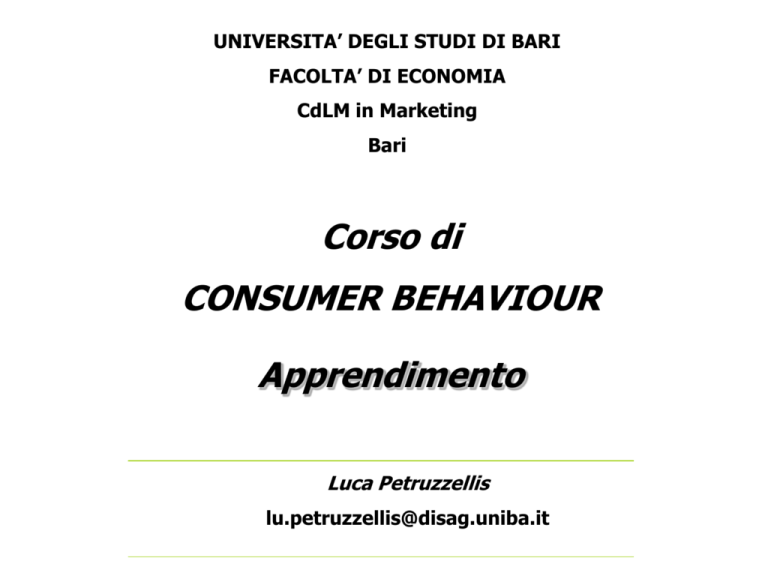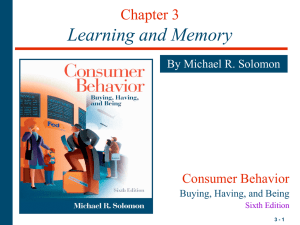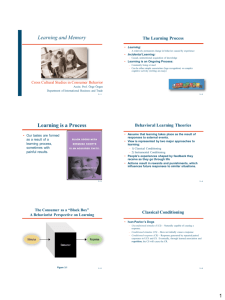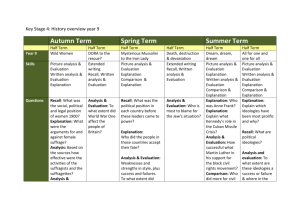Learning
advertisement

UNIVERSITA’ DEGLI STUDI DI BARI FACOLTA’ DI ECONOMIA CdLM in Marketing Bari Corso di CONSUMER BEHAVIOUR Apprendimento Luca Petruzzellis lu.petruzzellis@disag.uniba.it The Learning Process • Learning: – A relatively permanent change in behavior caused by experience • Incidental Learning: – Casual, unintentional acquisition of knowledge • Learning is an Ongoing Process: – Constantly being revised – Can be either simple association (logo recognition) or complex cognitive activity (writing an essay) Learning is a Process • Our tastes are formed as a result of a learning process, sometimes with painful results. The Consumer as a “Black Box” A Behaviorist Perspective on Learning Figure 3.1 Classical Conditioning • Ivan Pavlov’s Dogs – Unconditioned stimulus (UCS) – Naturally capable of causing a response. – Conditioned stimulus (CS) – Does not initially cause a response – Conditioned response (CR) – Response generated by repeated paired exposures to UCS and CS. Eventually, through learned association and repetition, the CS will cause the CR. Discussion Question • In the 1980’s, the Lacoste crocodile was an exclusive logo symbolizing casual elegance. When it was repeated on baby clothes and other items, it lost its cache and began to be replaced by contenders such as the Ralph Lauren Polo Player. • Can you thing of other logos that have lost their prestige due to repetition? Marketing Applications of Behavior Learning Principles • Brand Equity: – A brand has strong positive associations in a consumer’s memory and commands loyalty. • Applications of Repetition • Applications of Conditioned Product Associations: – Semantic associations – Phonemes Loyalty to Brands • Rewarding consumers with frequent flyer miles is an effective way to reinforce them and build brand loyalty. Marketing Applications of Behavior Learning Principles (cont.) • Applications of Stimulus Generalization: – Family branding – Product line extensions – Licensing – Look-alike packaging • Applications of Stimulus Discrimination: – Consumers learn to differentiate a brand from its competitors – Unique attributes of the brand Components of Observational Learning Figure 3.3 Applications of Cognitive Learning Principles • Consumers learn vicariously by seeing others receive reinforcement for their behaviors. • Marketers can reinforce or punish consumers indirectly by showing what happens to desirable models who do or do not use their products. • Consumers’ evaluations of models are not limited to stimulus-response connections. – Attractiveness can be based on several components (e.g. physical attractiveness, expertise, similarity to the evaluator) The Role of Memory in Learning • Memory – A process of acquiring and storing information such that it will be available when needed. • Stages of Memory – Encoding stage • Information entered in a recognizable way – Storage stage • Knowledge integrated into what is already there and warehoused – Retrieval stage • The person accesses the desired information The Memory Process Figure 3.4 Memory and Advertising This Brazilian ad illustrates that external memory aids like Post-Its can help us to remember many of the details of modern life. Encoding Information for Later Retrieval • Types of meaning: – Sensory meaning (e.g. color or shape) – Sense of familiarity (e.g. seeing a food that we have tasted) – Semantic meaning: Symbolic associations (e.g. rich people drink champagne) • Personal relevance: – Episodic memories: Relate to events that are personally relevant – Flashbulb memories: Especially vivid associations – Narrative: An effective way of persuading people to construct a mental representation of the information that they are viewing Memory Systems • Sensory Memory: – Very temporary storage of information we receive from our senses • Short-Term Memory (STM): – Limited period of time & limited capacity – Working memory (i.e., holds memory we are currently processing) • Long-Term Memory (LTM): – Can retain information for a long period of time – Elaboration rehearsal is required: Process involves thinking about a stimulus and relating it to information already in memory Storing Information in Memory • Multiple Store Models of Memory: – Traditional perspective which assumes that STM & LTM are separate systems. • Activation Models of Memory: – Argues that different levels of processing occur depending on the nature of the processing task. – The more effort it takes to process information, the more likely that information will be placed in LTM. Storing Information in Memory (cont.) • Associative Networks: – Contains many bits of related information organized according to some set of relationships – Knowledge structures: Complex “spider webs” filled with pieces of data – Hierarchical processing model: Message is processed in a bottom-up fashion (i.e., starts at a basic level and is subject to increasingly complex processing which requires increased cognitive capacity) – Node: A concept related to a category – An associative network is developed as links form between nodes. An Associative Network for Perfumes Figure 3.6 Storing Information in Memory (conc.) • Spreading Activation: – A process which allows consumers to shift back and forth between levels of meaning • Levels of Knowledge: – Knowledge is coded at different levels of abstraction and complexity. – Proposition (a.k.a. belief): A larger unit of meaning (i.e., formed by combinations of nodes) – Schema: A cognitive framework (comprised of propositions) developed through experience • Script: A type of schema consisting of a sequence of events expected by an individual Retrieving Information for Purchase Decisions • Factors Influencing Retrieval: – Physiological Factors (e.g. age) – Situational Factors: • Pioneering brand: First brand to enter a market. Is generally easier to retrieve from memory. • Descriptive brand names easier to recall than names that do no provide cues to what the product is. – Viewing environment: Commercials shown first in a series of ads are recalled better than those shown last. – Postexperience advertising effects: • When consumers confuse recently viewed ads with their own experiences. Retrieving Information for Purchase Decisions (cont.) • State-Dependent Retrieval: – (a.k.a. mood congruence effect) A process by which consumers are better able to access info if their mood is the same at the time of their recall as when the info was learned. – A few marketing researchers use hypnosis to dredge up past memories of experiences with products. • Familiarity and Recall: – Prior familiarity enhances recall. • Salience and Recall: – Salience: The prominence or level of activation of stimuli in memory – Von Restorff Effect: Any technique that increases the novelty of a stimulus also improves recall. Pictorial versus Verbal Cues • There is some evidence for the superiority of visual memory over verbal memory. • Pictorial ads may enhance recall, but do not necessarily improve comprehension. • How many of these Ad icons can you remember from the picture alone? Factors Influencing Forgetting • Decay: – Structural changes in the brain produced by learning simply go away. • Retroactive Interference: – Consumers forget stimulus-response associations when new responses to the same or similar stimuli are learned. • Proactive Interference: – As new responses are learned, a stimulus loses its effectiveness in retrieving the old response. • Part-list Cueing Effect: – When only a portion of the items in a category are presented to consumers, the omitted items are not as easily recalled. Products as Memory Markers • Products and ads can serve as powerful retrieval cues. – Autobiographical memories: Consumer memories related to their own past. – Mnemonic qualities: Aspects of a consumer’s possessions that serve as a form of external memory which prompts the retrieval of episodic memories. • The Marketing Power of Nostalgia – Spontaneous recovery: The ability of a stimulus to evoke a response years after it is initially perceived. • Memory and Aesthetic Preferences – Ads and products that remind consumers of their past also help to determine what they like now. Nostalgia Appeal Fossil’s product designs evoke memories of earlier classic designs Measuring Memory for Marketing Stimuli • Recognition Versus Recall: – Two basic measures of impact. • Typical recognition test: Subjects are shown ads and asked if they have seen them before. • Typical recall test: Subjects are asked to independently think of what they have seen without being prompted first. • The Starch Test – A widely used commercial measure of advertising recall for magazines. Discussion Question • Ads with celebrities like Britney Spears tend to have very high recall rates. • Name some ads with celebrities that you can recall easily. Why does the celebrity association with the ad aid your recall? Problems with Memory Measures • Response Biases – A contaminated result due to the instrument or the respondent, rather than the object that is being measured. • Memory Lapses – Unintentionally forgetting information: • Omitting: Leaving facts out • Averaging: “Normalizing” memories by not reporting extreme cases • Telescoping: Inaccurate recall of time • Memory for Facts Versus Feelings – Recall is important but not sufficient to alter consumer preferences – More sophisticated attitude-changing strategies are needed.







